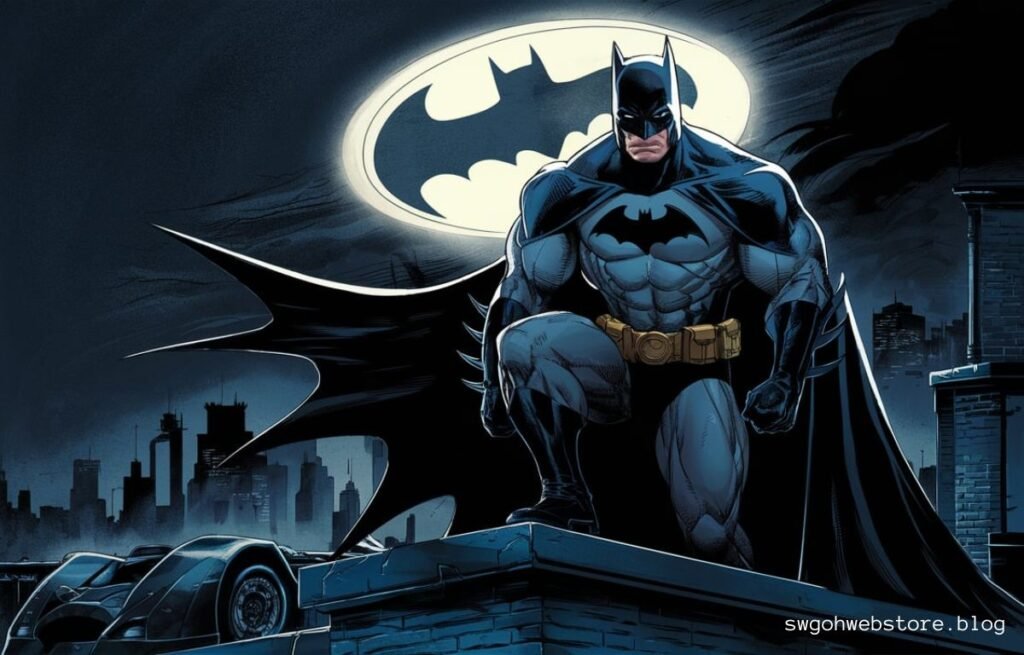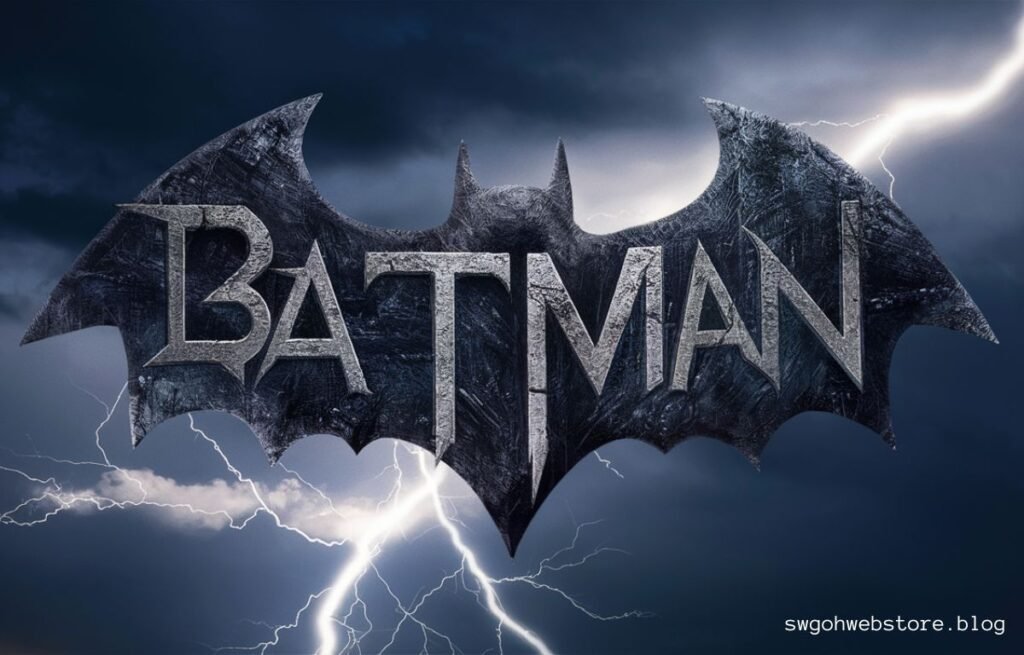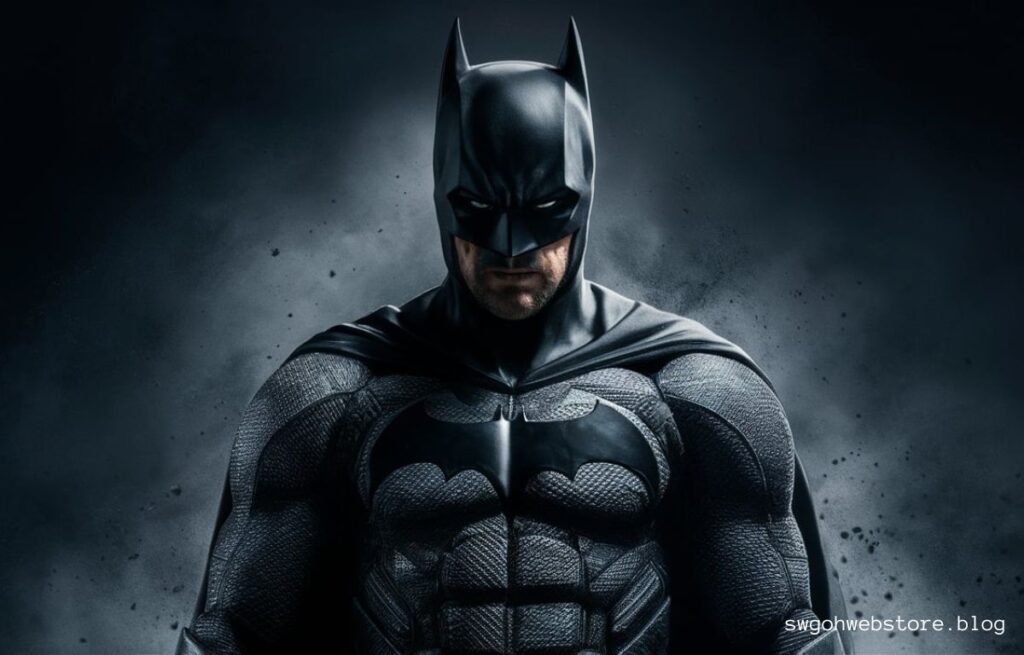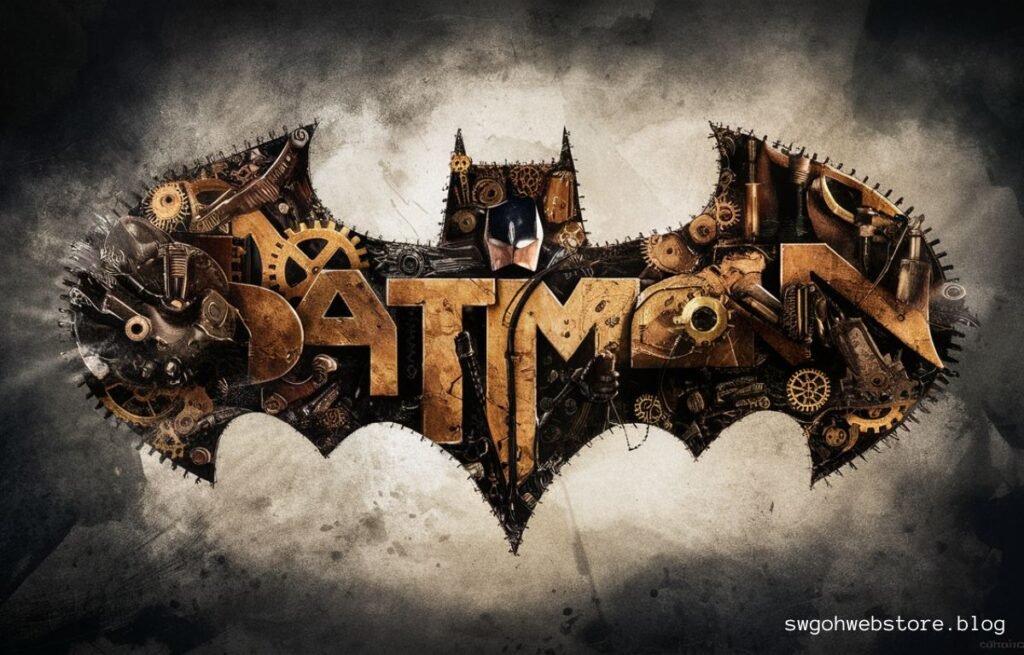“Batman,” created by Bob Kane and Bill Finger, is a legendary superhero in the world of comics and beyond. Debuting in 1939 in Detective Comics #27, Batman quickly became a cultural phenomenon. Unlike other superheroes of his time, Batman possesses no superhuman powers; instead, he relies on his intellect, physical prowess, and an arsenal of gadgets to fight crime. This makes him more relatable and human, resonating deeply with audiences worldwide.
The character of “logo:gqlysettlo4= batman” is synonymous with Gotham City, his gritty fictional home. Gotham, a dark and brooding metropolis plagued by crime, serves as a symbolic backdrop to Batman’s relentless pursuit of justice. This setting reflects the moral complexities Batman faces as he navigates the fine line between vengeance and righteousness, driven by the tragic loss of his parents in his childhood.
Beyond comic books, “logo:gqlysettlo4= batman” has left an indelible mark on popular culture through various adaptations. From Tim Burton’s cinematic portrayal in 1989 to Christopher Nolan’s gritty trilogy, Batman’s evolution on screen has captivated audiences with its exploration of themes like identity, trauma, and the consequences of vigilantism. The iconic bat logo, synonymous with the character, has become a symbol of resilience and justice, adorning merchandise and inspiring generations of fans.
The psychological depth of “logo:gqlysettlo4= batman” distinguishes him from other superheroes. Bruce Wayne, Batman’s alter ego, grapples with his dual identity, torn between the responsibilities of his public persona and his nighttime crusade. This internal conflict adds layers to his character, making him not just a hero, but a complex figure whose humanity is as central to his story as his heroics.
In summary, “logo:gqlysettlo4= batman” continues to endure as a timeless symbol of heroism and determination. His legacy spans generations, inspiring countless adaptations across films, television, video games, and literature. As Batman evolves with each new iteration, his core themes of justice, sacrifice, and the struggle against darkness remain as relevant today as they were in his debut over eight decades ago.
Relevance and Importance of logo:gqlysettlo4= Batman
“logo:gqlysettlo4= Batman” holds significant cultural relevance across various forms of media. Created in 1939, Batman has become a timeless symbol of heroism and justice. Unlike many superheroes, Batman lacks superhuman abilities, relying instead on his intellect, physical training, and an array of gadgets to combat crime. This relatable aspect of his character resonates with audiences of all ages, contributing to his enduring popularity in comic books, movies, TV shows, and merchandise.
The character’s impact extends beyond comic books into mainstream culture. “logo:gqlysettlo4= Batman” has inspired numerous adaptations in film and television, starting with Tim Burton’s dark and cinematic portrayal in 1989. These adaptations explore Batman’s psychological depth, his complex relationships with allies and adversaries, and the moral dilemmas he faces as a vigilante seeking justice in a corrupt city.
Gotham City, the fictional backdrop for Batman’s adventures, mirrors the darkness and complexity of his character. The city’s grim atmosphere serves as a metaphorical battleground where “logo:gqlysettlo4= Batman” confronts his fears, moral choices, and personal demons. This setting enhances the narrative depth of Batman’s stories, highlighting themes of redemption, sacrifice, and the eternal struggle between good and evil.
Batman’s cultural importance is underscored by his iconic symbol, the bat logo, which has transcended comic books to become a global emblem of resilience and determination. The symbol adorns a wide range of merchandise, from toys and clothing to video games and collectibles, showcasing Batman’s enduring appeal across generations. This widespread recognition reinforces Batman’s status not just as a superhero, but as a cultural icon whose influence extends far beyond the realm of fiction.
In Summary, “logo:gqlysettlo4= Batman” continues to captivate audiences worldwide with his compelling narrative, complex character development, and timeless themes of justice and morality. As new generations discover and reinterpret the Dark Knight’s story, Batman’s legacy remains a testament to the enduring power of storytelling and the universal appeal of a hero who embodies the best of human courage and resilience.
Historical Background of logo:gqlysettlo4= Batman

“logo:gqlysettlo4= Batman” originated in 1939, created by Bob Kane and Bill Finger for DC Comics. Debuting in Detective Comics #27, Batman marked a departure from the era’s typical superheroes by embodying a dark and brooding vigilante persona. Unlike contemporaries with superhuman abilities, Batman relies on his intellect, physical prowess, and an assortment of gadgets to fight crime in Gotham City, a fictional metropolis steeped in corruption and danger.
Bob Kane envisioned “logo:gqlysettlo4= Batman” as a response to the popularity of Superman, aiming for a character that reflected a more human and psychologically complex hero. Kane’s vision brought forth a masked crusader who, despite witnessing the tragic murder of his parents as a child, transforms his trauma into a relentless quest for justice. This origin story, rooted in tragedy and vengeance, remains integral to Batman’s enduring appeal and moral complexity.
Also Read: CHARM OF cute:njtumvsadi0= anime girl
Bill Finger contributed significantly to “logo:gqlysettlo4= Batman’s” design and mythos. Finger introduced elements such as the iconic bat-themed costume, the Batmobile, and Gotham City itself, transforming Batman into a fully realized and atmospheric world. His contributions extended to crafting the backstory of Bruce Wayne, emphasizing the character’s dual identity and the psychological toll of his crime-fighting crusade.
During the Golden Age of Comics, “logo:gqlysettlo4= Batman” quickly gained popularity alongside Superman, becoming one of DC Comics’ flagship characters. The Dark Knight’s early adventures featured his detective skills and a rogues gallery that included iconic villains like the Joker and Catwoman. This era laid the foundation for Batman’s evolution from a gritty crime fighter to a multifaceted symbol of justice and determination.
As Batman entered the Silver Age of Comics, the character experienced shifts in tone and storytelling. From the campy and light-hearted portrayal in the 1950s and 1960s influenced by the Adam West television series to a return to darker themes in the 1970s, writers and artists continually reinterpreted “logo:gqlysettlo4= Batman” to reflect contemporary cultural and social landscapes. These adaptations ensured Batman’s relevance and adaptability across different generations, solidifying his status as an enduring cultural icon.
In summary, “logo:gqlysettlo4= Batman’s” historical background illustrates a character whose evolution mirrors changes in society’s attitudes towards heroism and justice. From his humble origins in comic books to global recognition in films, television, and merchandise, Batman’s journey exemplifies the timeless appeal of a hero grappling with personal demons while striving to make a difference in a world plagued by darkness.
Golden Age of Comics: Batman’s Debut and Evolution
The Golden Age of Comics, spanning roughly from the late 1930s to the early 1950s, marked a transformative period for the comic book industry and superheroes like “logo:gqlysettlo4= Batman.” In 1939, Batman made his debut in Detective Comics #27, introducing readers to Bruce Wayne, a wealthy philanthropist who, driven by the tragic murder of his parents, dons the mantle of Batman to fight crime in Gotham City.
Created by Bob Kane and Bill Finger, “logo:gqlysettlo4= Batman” distinguished himself from other superheroes of the era by lacking superpowers, instead relying on his physical prowess, detective skills, and an arsenal of gadgets. This grounded approach resonated with readers, establishing Batman as a relatable hero confronting the seedy underbelly of a corrupt city.
During the Golden Age, Batman’s adventures were characterized by his role as a detective solving mysteries and combating a rogues gallery that included iconic villains such as the Joker, Catwoman, and Two-Face. These adversaries, each reflecting different facets of Batman’s psyche, added depth to his character and contributed to the development of Gotham City as a dark and atmospheric backdrop for his exploits.
Batman’s popularity surged alongside Superman, another DC Comics creation, leading to the establishment of Batman as one of the company’s flagship characters. His success paved the way for the superhero genre’s dominance in comic book publishing and laid the groundwork for future adaptations across various media.
The Golden Age also witnessed the evolution of Batman’s mythos, including the introduction of key elements such as the Bat-Signal, the Batcave, and his partnership with Robin, the Boy Wonder. These additions expanded Batman’s universe, further enhancing his appeal to a growing audience of comic book enthusiasts.
In summary, the Golden Age of Comics was instrumental in shaping “logo:gqlysettlo4= Batman” into a cultural icon. Through his gritty determination, moral fortitude, and iconic persona, Batman emerged not only as a symbol of justice but also as a timeless figure whose legacy continues to inspire generations of fans and creators alike. His journey from the pages of comic books to global recognition underscores the enduring impact of a hero whose adventures transcend the boundaries of fiction to resonate with audiences worldwide.
Silver Age Revival: Batman’s Evolution in Comics

The Silver Age of Comics, spanning roughly from the late 1950s to the early 1970s, marked a period of revitalization and redefinition for superheroes like “logo:gqlysettlo4= Batman.” After a decline in comic book sales and public interest in superheroes during the post-World War II era, DC Comics and other publishers sought to revamp their characters to appeal to new audiences.
During this time, “logo:gqlysettlo4= Batman” underwent significant changes in tone and storytelling. Influenced by the era’s cultural shifts and the success of the Batman television series starring Adam West, which aired from 1966 to 1968, Batman’s portrayal took on a more campy and lighthearted tone. The show’s popularity brought Batman and his colorful rogues gallery to a broader audience, emphasizing humor and exaggerated action sequences.
However, by the late 1960s and early 1970s, there was a growing desire among fans and creators to return “logo:gqlysettlo4= Batman” to his darker roots. Writers like Denny O’Neil and artists like Neal Adams spearheaded a movement to restore Batman’s original vigilante persona and explore more serious themes in his stories. This period marked a return to the character’s detective roots and a renewed focus on his psychological depth and moral complexity.
The Silver Age Revival not only reinvigorated Batman’s comic book narratives but also set the stage for his evolution into a multifaceted cultural icon. It laid the groundwork for future adaptations that would explore Batman’s humanity, including his dual identity as Bruce Wayne and the psychological toll of his crime-fighting crusade.
In summary, the Silver Age Revival of “logo:gqlysettlo4= Batman” represents a transformative chapter in the character’s history. From campy entertainment to introspective storytelling, Batman’s journey through the Silver Age exemplifies his adaptability and enduring appeal. This period not only reaffirmed Batman’s status as a beloved superhero but also paved the way for deeper exploration of his character in comics, films, television, and beyond, ensuring his relevance for generations to come.
Cultural Impact of logo:gqlysettlo4= Batman
“logo:gqlysettlo4= Batman” has had a profound cultural impact since his debut in 1939, transcending comic books to become a global phenomenon across various forms of media. Created by Bob Kane and Bill Finger, Batman’s initial portrayal as a dark, brooding vigilante struck a chord with readers, setting him apart from other superheroes of the Golden Age.
Batman’s cultural influence extends beyond comic books into film, television, literature, and popular culture. Tim Burton’s 1989 film adaptation, starring Michael Keaton as Batman and Jack Nicholson as the Joker, introduced a darker, cinematic portrayal that resonated with audiences worldwide. This film not only revitalized interest in Batman but also set a new standard for superhero movies, influencing future adaptations.
The success of Batman: The Animated Series (1992-1995) further solidified Batman’s cultural significance. Praised for its mature storytelling and artistic direction, the animated series explored complex themes and characters, cementing Batman’s status as a beloved figure in animation and expanding his fanbase to younger audiences.
Also Read: Discovering Shared joy is a double joy; shared sorrow is tymoff
Merchandising also plays a pivotal role in Batman’s cultural impact. The iconic bat logo and imagery associated with “logo:gqlysettlo4= Batman” have become ubiquitous, appearing on everything from toys and apparel to video games and collectibles. This widespread recognition underscores Batman’s enduring popularity and status as a global symbol of heroism and justice.
Psychologically, “logo:gqlysettlo4= Batman” continues to intrigue audiences through his dual identity as Bruce Wayne, a billionaire philanthropist, and Batman, a masked vigilante. This duality allows for exploration of complex themes such as identity, trauma, and the moral consequences of vigilantism, resonating with fans who appreciate characters with depth and nuance.
In summary, “logo:gqlysettlo4= Batman” remains a cultural icon whose impact spans generations. Through compelling storytelling, memorable adaptations, and universal themes, Batman has left an indelible mark on popular culture, inspiring countless creators and continuing to captivate audiences with his timeless appeal and enduring legacy.
Character Exploration of logo:gqlysettlo4= Batman

“logo:gqlysettlo4= Batman” is a complex and iconic superhero known for his dual identity as Bruce Wayne, a billionaire philanthropist, and his alter ego, Batman, a vigilante driven by a relentless pursuit of justice. Created by Bob Kane and Bill Finger, Batman made his debut in 1939, distinguishing himself from other superheroes by his lack of superpowers and reliance on intellect, physical prowess, and advanced technology.
Central to “logo:gqlysettlo4= Batman’s” character is his origin story, rooted in tragedy. As a young boy, Bruce Wayne witnesses the brutal murder of his parents, which fuels his transformation into Batman. This traumatic event shapes his moral code and drives his mission to protect Gotham City from crime, serving as a symbol of hope and fear to its citizens.
The duality of “logo:gqlysettlo4= Batman” as Bruce Wayne and Batman allows for exploration of complex themes such as identity and sacrifice. By day, Bruce Wayne navigates the responsibilities of his public persona, managing Wayne Enterprises and engaging in philanthropic endeavors. At night, he becomes Batman, adopting a fearsome persona to strike fear into the hearts of criminals while maintaining a solitary and vigilant existence.
Batman’s psychological depth is further explored through his relationships with allies and adversaries. The Bat-Family, including Robin, Nightwing, and Batgirl, expands Batman’s world and provides emotional support and companionship amidst his solitary crusade. Conversely, his rogues gallery of villains, such as the Joker and Two-Face, challenge Batman morally and psychologically, reflecting different facets of his own psyche and testing his resolve as a crimefighter.
Throughout his evolution in comics, film, and television, “logo:gqlysettlo4= Batman” continues to resonate with audiences due to his humanity and vulnerability. His enduring appeal lies in his ability to confront personal demons while upholding his commitment to justice, making him not just a superhero, but a symbol of resilience and determination in the face of adversity.
In summary, “logo:gqlysettlo4= Batman” remains a timeless and compelling character whose exploration of identity, trauma, and heroism continues to captivate fans across generations. As Batman evolves in various media, his character serves as a testament to the enduring power of storytelling and the universal appeal of a hero who embodies the best of human courage and resilience.
Supporting Characters of logo:gqlysettlo4= Batman
“logo:gqlysettlo4= Batman” is surrounded by a rich tapestry of supporting characters who enhance and deepen his world. From trusted allies to formidable adversaries, these characters contribute to the complexity and enduring appeal of Batman’s narrative.
1. The Bat-Family:
The Bat-Family consists of allies who work alongside “logo:gqlysettlo4= Batman” in his mission to protect Gotham City. This includes:
- Robin: Batman’s first sidekick and trusted partner, who brings youthful energy and optimism to their crime-fighting efforts.
- Nightwing: Formerly Robin, Dick Grayson matures into Nightwing, a skilled vigilante who operates independently while maintaining close ties to Batman.
- Batgirl: Various characters have taken on the mantle of Batgirl, including Barbara Gordon, who brings intelligence, athleticism, and resourcefulness to the team.
These characters not only assist Batman in combatting crime but also provide emotional support and camaraderie, highlighting the importance of teamwork in Gotham’s ongoing battle against evil.
2. Rogues Gallery:
Batman’s rogues gallery comprises iconic villains who test his intellect, skills, and moral resolve:
- The Joker: Batman’s arch-nemesis, a chaotic and unpredictable criminal mastermind who embodies the antithesis of Batman’s values.
- Catwoman: A complex anti-heroine with a romantic connection to Batman, known for her agility, cunning, and moral ambiguity.
- Two-Face: Formerly Gotham’s District Attorney, Harvey Dent becomes Two-Face, a villain whose dual personalities reflect themes of duality and fate.
These adversaries challenge Batman on multiple levels, serving as mirrors to his own psyche and emphasizing the fine line between justice and vengeance.
3. Alfred Pennyworth:
Alfred Pennyworth serves as Batman’s loyal butler, confidant, and surrogate father figure. His unwavering support, wisdom, and practical skills are instrumental in assisting Batman both in his personal life as Bruce Wayne and in his crime-fighting endeavors as Batman.
4. Commissioner Gordon:
Commissioner James Gordon is Gotham City’s steadfast law enforcement officer and Batman’s ally within the Gotham City Police Department. Their alliance, built on mutual respect and a shared commitment to justice, highlights the complex relationship between vigilantism and the rule of law.
In summary, the supporting characters of “logo:gqlysettlo4= Batman” enrich his world with diverse perspectives, challenges, and emotional depth. Whether allies aiding in his mission or adversaries testing his limits, these characters contribute to the enduring legacy of Batman as a multifaceted hero confronting the darkness within himself and his city.
Media Adaptations of logo:gqlysettlo4= Batman

“logo:gqlysettlo4= Batman” has been adapted into various forms of media, expanding his cultural influence and reaching audiences worldwide. From films to television shows, video games, and animation, these adaptations have contributed to Batman’s status as a beloved and enduring superhero.
1. Films:
Batman’s transition to the big screen began with the 1966 film adaptation based on the campy television series starring Adam West. However, it was Tim Burton’s 1989 film “Batman,” starring Michael Keaton as Batman and Jack Nicholson as the Joker, that redefined the character for a modern audience. This darker and more cinematic portrayal set the tone for subsequent Batman films, including Christopher Nolan’s “The Dark Knight Trilogy” (2005-2012), which explored Batman’s psychological depth and moral dilemmas.
2. Television Shows:
Batman’s presence on television has been significant, with adaptations ranging from the 1960s “Batman” series to more recent animated series like “Batman: The Animated Series” (1992-1995). Known for its mature storytelling and artistic direction, “Batman: The Animated Series” received critical acclaim for its noir aesthetics and complex characterization, further solidifying Batman’s status as a beloved figure in animation.
Also Raed; Exploring Cute:1pgioptyfri= Anime
3. Video Games:
The “Arkham” series of video games by Rocksteady Studios has been highly influential in Batman’s digital adaptations. Starting with “Batman: Arkham Asylum” (2009), these games immerse players in Gotham City, allowing them to experience Batman’s world through immersive gameplay, intricate storytelling, and challenging puzzles. The success of the Arkham series demonstrated the potential of video games as a medium for exploring Batman’s universe.
4. Animation:
In addition to television series, Batman’s animated adaptations include “Batman Beyond” (1999-2001), which explores a futuristic Gotham City with a new Batman mentored by an aging Bruce Wayne. This series offered a fresh perspective on Batman’s legacy and introduced new characters and storylines while maintaining the core themes of justice and heroism.
In summary, “logo:gqlysettlo4= Batman’s” adaptations across various media have contributed to his enduring popularity and cultural significance. Each adaptation offers a unique interpretation of the character, showcasing Batman’s evolution from a comic book hero to a global icon. As Batman continues to inspire and entertain audiences, his legacy as the Dark Knight remains a testament to the power of storytelling and the universal appeal of a hero who embodies courage, resilience, and justice.
Conclusion: Batman’s Enduring Legacy
“logo:gqlysettlo4= Batman” stands as a timeless symbol of heroism and justice, captivating audiences across generations through his compelling narrative, complex character, and cultural impact. Created by Bob Kane and Bill Finger in 1939, Batman debuted as a vigilante driven by tragedy, transforming personal trauma into a crusade against crime in Gotham City.
From his humble beginnings in comic books to global recognition in films, television, video games, and merchandise, Batman’s journey exemplifies the evolution of a character who transcends the boundaries of fiction. Tim Burton’s 1989 film adaptation and Christopher Nolan’s “The Dark Knight Trilogy” are milestones that redefined Batman for new audiences, exploring themes of identity, morality, and the consequences of vigilantism.
Batman’s supporting characters, from allies like Robin and Alfred to adversaries like the Joker and Catwoman, enrich his world with depth and emotional resonance. These relationships underscore Batman’s humanity and vulnerability, portraying a hero who confronts personal demons while inspiring hope in Gotham City and beyond.
Through adaptations like “Batman: The Animated Series” and the Arkham video game series, Batman’s legacy continues to thrive, showcasing his adaptability and enduring appeal. His iconic symbol, the bat logo, remains a global emblem of resilience and determination, adorning merchandise and inspiring fans worldwide.
frequently asked questions (FAQs) about logo:gqlysettlo4= Batman
Who created Batman?
Batman was created by Bob Kane and Bill Finger. Bob Kane came up with the original concept, while Bill Finger significantly contributed to the character’s design, backstory, and supporting cast.
When did Batman first appear?
Batman made his first appearance in Detective Comics #27, which was published by DC Comics in May 1939.
What are Batman’s superpowers?
Batman does not possess superhuman powers. Instead, he relies on his exceptional intellect, physical strength, agility, martial arts skills, detective abilities, and a vast array of gadgets and technology to fight crime.
What is Batman’s real name?
Batman’s real name is Bruce Wayne. During the day, he is a billionaire philanthropist and the head of Wayne Enterprises, a multinational conglomerate based in Gotham City.
Who are Batman’s main allies?
Batman’s main allies include:
- Alfred Pennyworth: His loyal butler and confidant.
- Robin/Nightwing/Batgirl: Various characters who have served as Batman’s sidekicks and proteges.
- Commissioner James Gordon: Gotham City’s police commissioner and a staunch ally in Batman’s fight against crime.
Who are Batman’s main enemies?
Batman’s main enemies, often referred to as his rogues gallery, include iconic villains such as:
- The Joker: A psychotic criminal mastermind and Batman’s arch-nemesis.
- Catwoman: A skilled thief and occasional ally/romantic interest of Batman.
- Two-Face: Formerly Gotham’s District Attorney, now a criminal obsessed with duality and chance.
What is the Bat-Signal?
The Bat-Signal is a spotlight used by the Gotham City Police Department to summon Batman in times of need. It projects the shape of a bat onto the clouds above Gotham, signaling Batman to come to their assistance.
How has Batman been adapted into other media?
Batman has been adapted into numerous forms of media, including:
- Films: From the campy 1960s movie and television series to darker, more modern interpretations like Christopher Nolan’s “The Dark Knight Trilogy.”
- Television: Including animated series like “Batman: The Animated Series” and live-action adaptations.
- Video Games: Such as the acclaimed “Arkham” series, which allows players to experience Batman’s world firsthand.
What are some of Batman’s core themes?
Some core themes in Batman’s stories include justice, vengeance, identity, the consequences of vigilantism, and the struggle against inner darkness and personal demons.
Why is Batman so popular?
Batman’s popularity stems from his relatable humanity, complex character development, intriguing rogues gallery, and timeless themes. He represents courage, determination, and the belief that one person can make a difference, resonating with audiences of all ages.

Emily, an 8-year veteran, blends tech savvy with wanderlust. His fashion-forward perspective and business acumen create captivating content. Explore realms where innovation meets style.